|
|
Jersey Geology Trail |
Granite. (Lat. granum=grain; Gk. lithos=stone), Granophyre & Granodiorite. |
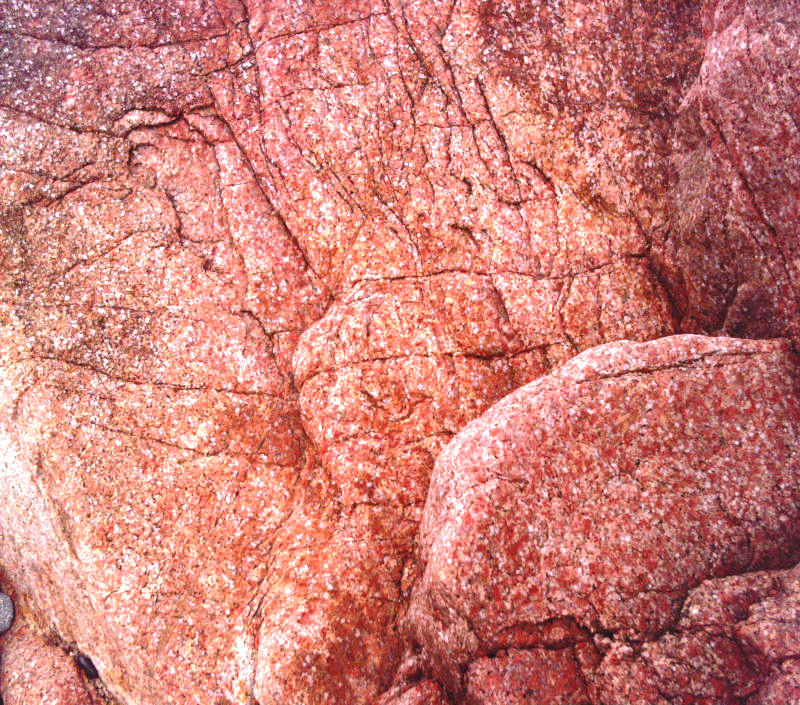 |
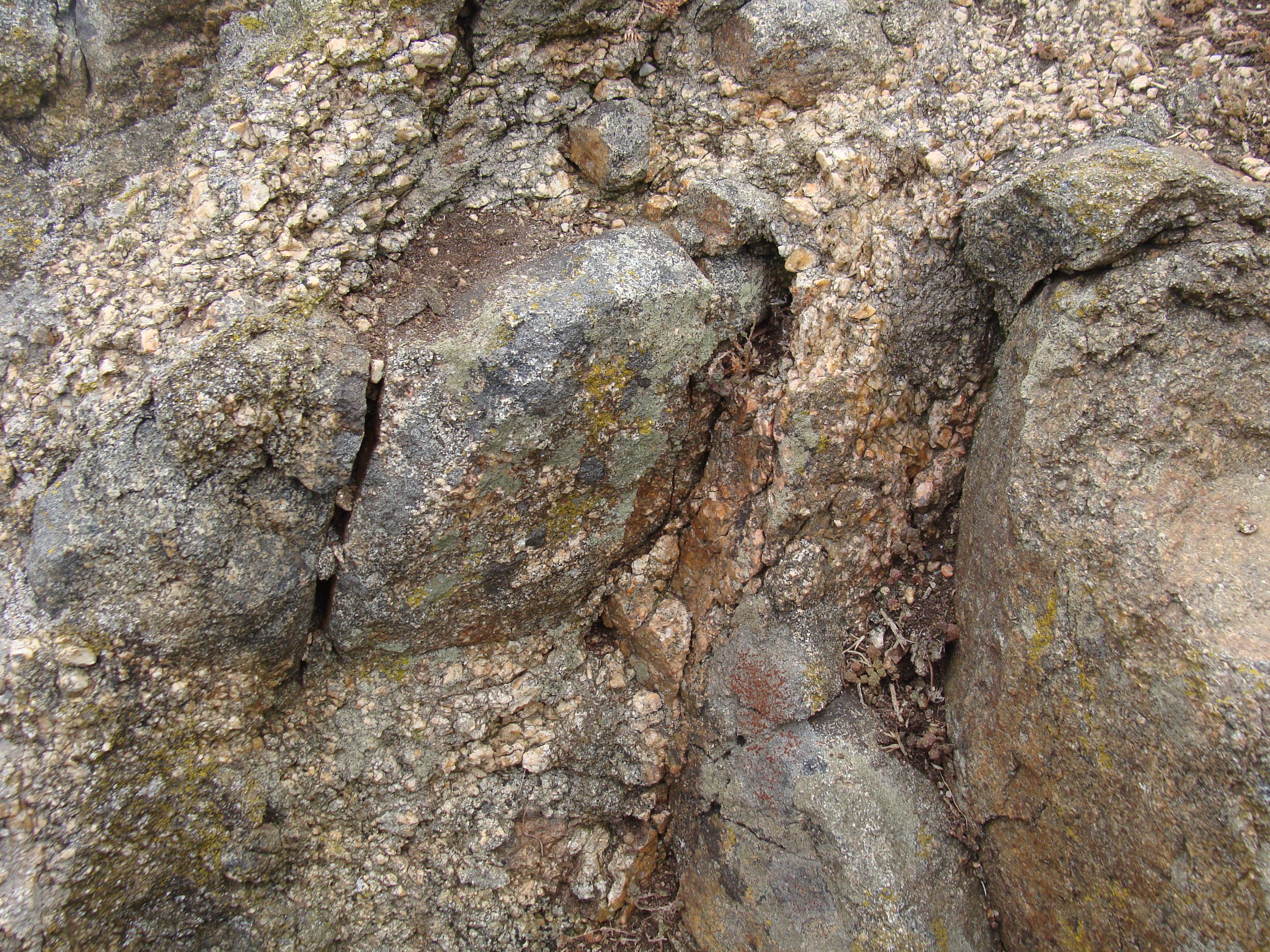 |
South-west Corbière granite, Portelet. |
Granodiorite, Sorel Point. |
| |
Granite is a light coloured, grey to pink, coarsely crystalline, plutonic, acid igneous rock composed of quartz, alkali feldspar, generally orthoclase, and biotite and/or muscovite. It forms batholiths or small plutons, or dykes and veins from these masses. Granite can be formed in any of the following ways; by partial melting of old continental crust, or in situ replacement of continental crust (granitisation), or fractional crystallisation from basalt or from a combination of these (Allaby & Allaby, 1990, p. 240).
Granophyre is similar but with small scale graphic intergrowth (see Texture page) of the quartz and orthoclase or plagioclase feldspars formed in the groundmass at a late stage.
Granodiorite is similar to granite but along with quartz, contains more plagioclase feldspar than orthoclase, and more hornblende; it forms in the crust above subduction zones (Allaby & Allaby, 1990, p. 214). |
| |
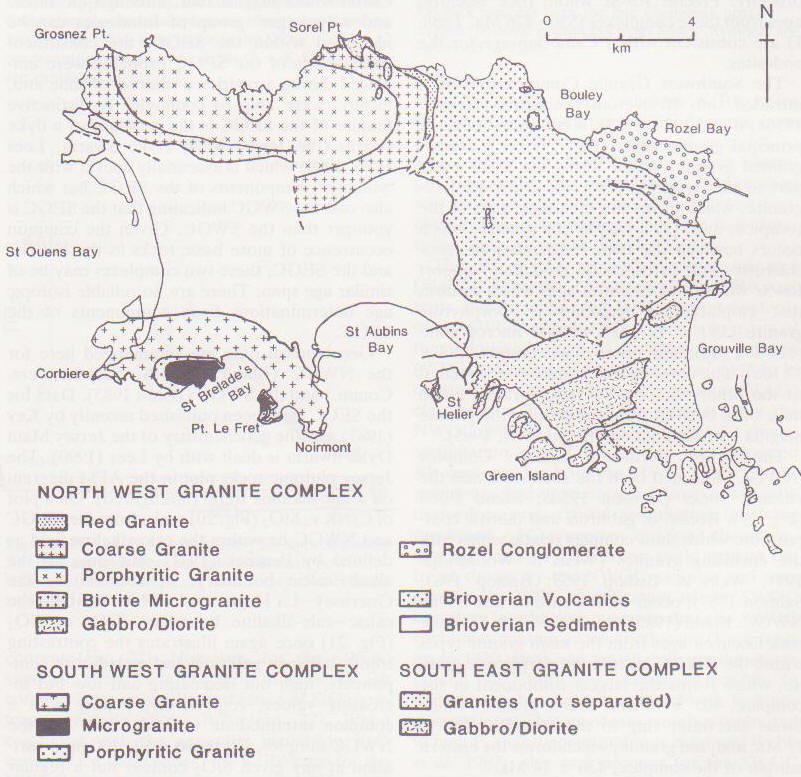 |
 |
Jersey granite outcrops from the detailed work of Brown, Power, Topley & D'Lemos (1990. p. 195) alongside the sea floor geology map (IGS Guernsey Sheet 49N 04W Solid Edition, 1976, the work of British & French geologists. The granite boundaries have been transferred from the first to the second map. |
| |
NB. Boundaries added in St. Aubin and St. Ouën's Bays are inferred because of the differences in the ages and rock types between the SW granites and SE granites/diorites, and the SW granites and NW granites/diorites; possible boundaries have been added in the SE granites from age data (Bishop & Bisson, 1989).
NB. In 1931, Soc. Jers. Geology Section members visited the offshore reefs in St Aubin's Bay between the SW and SE granite masses. In a motor boat under the guidance of Père Burdo, they found the following rocks from west to east:
Le Pignonet (W nr. Noirmont), red aplite granite; Les Grunes du Port & Les Sillettes ((W & S of bay), coarse granite; Ruaudière (mid-bay), Les Grunes aux Dardes (S) and Hinguette (SE), gabbro; Oyster Rock (nr. Eliz. Castle), mixture of plutonic rocks, mainly basic. The first outcrops resemble the SW granites (described below), the latter resemble those of the SE granites/diorites (Robinson, A. J. 1932. p.7). The concluding statement that 'the granite of Corbière is continuous with that of La Rocque' doesn't seem to question the possibility of a boundary between two different granitic suites or provinces. |
| |
The Granites. |
Three fascinating granite masses occur in Jersey and form the north west (NW), south west (SW) and south east (SE) corners of the island; they are well exposed and easily accessible, with interesting relationships to adjacent rocks and all within 15km of each other.
They are fascinating because two of them, the SW and the NW ones, consist of three and four different granites respectively, but of different ages, while the SE one consists of four different granites which have yet to produce reliable dates.
In addition, the NW and granite masses include gabbros and diorites, with structures and textures that make their relationships to each other even more interesting study material. It is noticeable that although the SW granite lacks the extensive diorite outcrops, there are many small relict patches and/or xenoliths of diorite which show interesting variations in composition and texture; they seem to form 'snapshots' of arrested stages of formation and alteration.
The granite, diorite and the other country rock contacts are well exposed in most cases so intrusive history and contact metamorphic textures can also be examined.
Finally, each mass has been intruded by many aplite, porphyritic aplite/felsite, dolerite and mica lamprophyre dykes and minor hornblende lamprophyres and olivine gabbros. Their relationships can be seen easily, especially where the dolerites are well exposed in the SE granite at Le Hocq and in the SW granite on the east side of Noirmont. In these areas, they are numerous enough to have been described as a dyke swarm (Lees, 1990, p. 273).
** The granites within each complex are illustrated under the title and then described. |
| |
The Southwest Igneous Complex. |
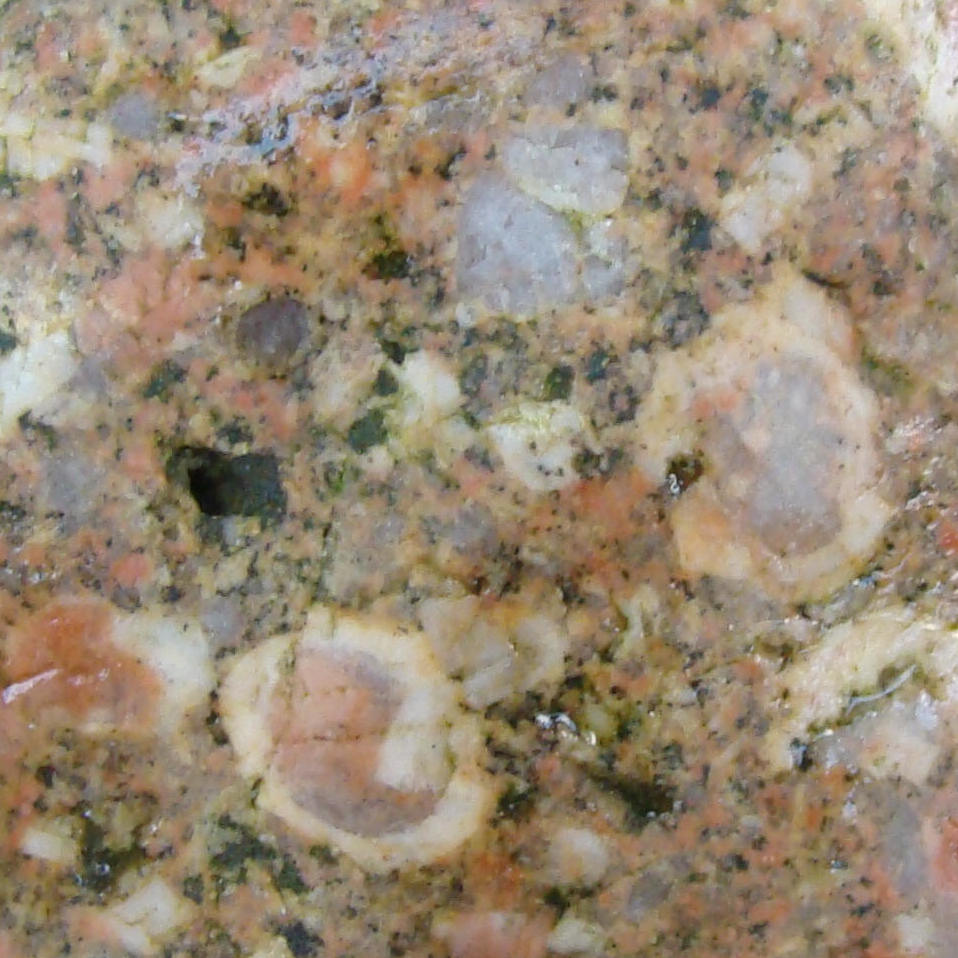 |
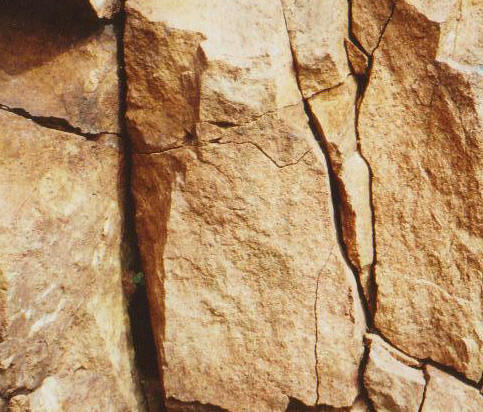 |
 |
La Moye, porphyritic granite. |
Beauport, aplogranite. |
La Corbière, coarse granite. |
| |
In 1989, three granites were identified in this complex (in order of age above, Brown et al, 1990) named the South-west granite by Bishop & Bisson (1989, p. 55-56). They are beautifully exposed around the south-west corner of the island from Belcroute Bay west to La Pulente and include the strikingly pink south coast cliffs from Noirmont Point westwards via Portelet and St. Brelade's Bays to La Corbière Point. The three granites, arranged concentrically in an oval shape (presently a semi circle open to the south due to erosion), with a whole-rock isochron age of 553 +/- 12 Ma (recalculated from 565 +/- 15 Ma) by Bishop & Bisson (loc.cit.) were described as follows: |
| |
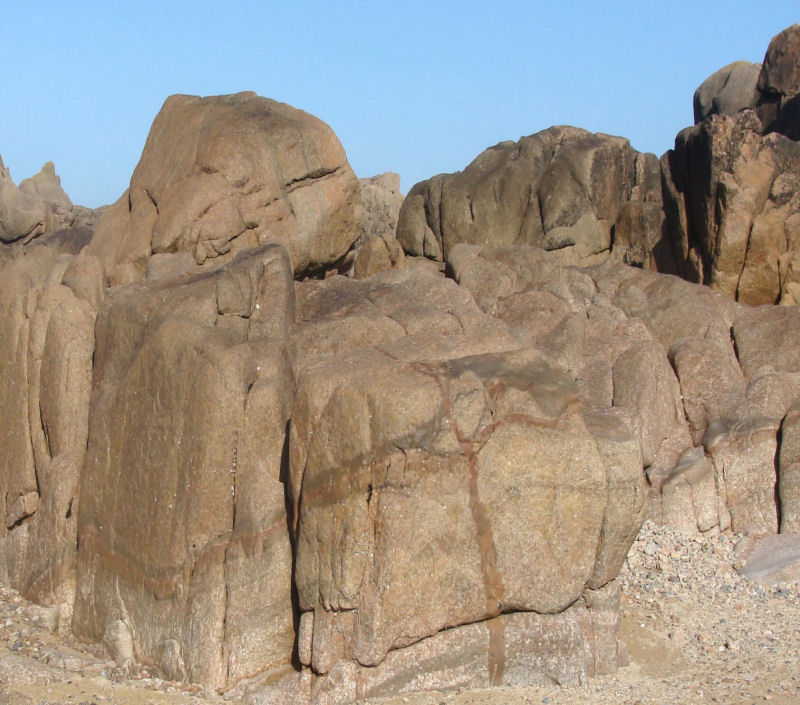 |
Corbière granite, beautifully banded & intruded by aplite dykes; causeway to La Corbière lighthouse. |
| |
1. The Corbière granite, is a pink to red, coarsely crystalline, equigranular granite with predominant quartz, orthoclase, hornblende and biotite which forms the outer ring. It is well exposed on the west coast, southwards from the quarry at La Carrière, across he wave-cut platform to La Corbière, and along the causeway to where the lighthouse stands on a well jointed stack, then eastwards for several hundred metres to beyond La Rosière. |
| |
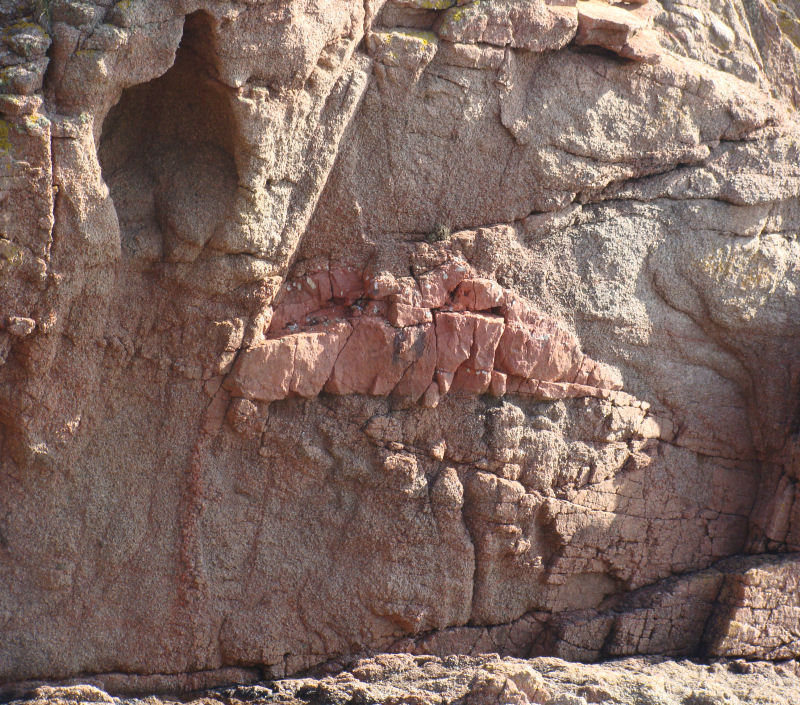 |
Isolated aplite lens (laccolith?) with quartz pegmatite (top left), La Rosière. |
| |
All along this section, textural changes and minor structures reveal some of its intrusive history, including that of later aplite and dolerite dykes. From here it follows a concentric route north and east round to Noirmont Point and the Ouaisné quarries via the old quarry in the cliffs at the back of Portelet Bay. It passes into an inner ring, c. 200m wide, of the porphyritic La Moye granite which passes into the inner aplitic Beau Port granite. On the foreshore at Ouaisné from the slipway to the west and south, these granites are exposed in fallen blocks (and in the quarries above), and the Corbière granite's association with these other porphyritic and aplo-granites described below can easily be seen. Here too, one can see, rarely for the SW granite, small inclusions (xenoliths) of dark grey diorite and very dark grey - black porphyritic diorite. Pink aplite dykes, quartz veins and small scale pegmatitic quartz patches can also be seen, while an E-W striking dolerite dyke showing interesting bifurcation and extensions into joints, crops out in a shallow gully in the easily accessible foreshore rocks. |
| |
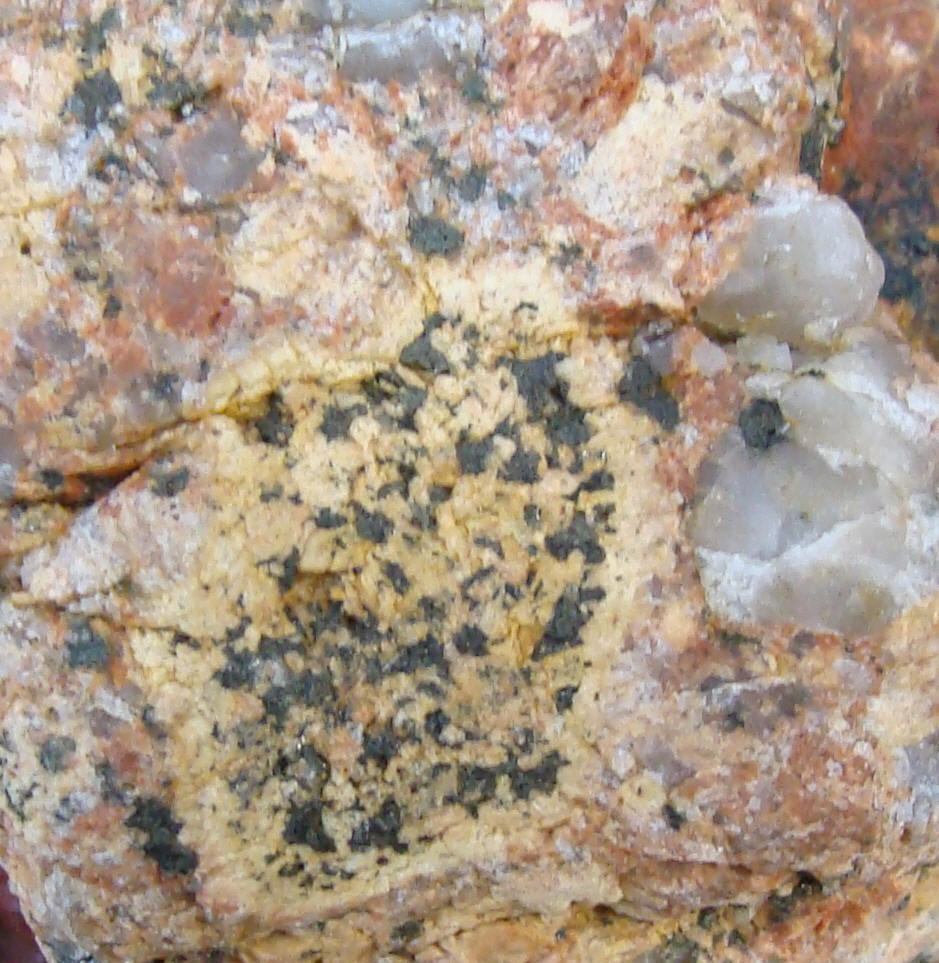 |
 |
Zoned feldspar, hornblende inclusions. |
Porphyritic La Moye granite, Ouaisné. |
| |
***Ensure that the above sections are examined on an ebbing tide.
2. La Moye granite, is a pink, porphyritic granite with large phenocrysts of orthoclase feldspar, some of which are zoned, set in a finer crystalline aplitic groundmass, and is exposed SSW of the prison and more accessibly on the western side of Noirmont Point at Ouaisné.
3. The Beau Port granite (initially the St. Brelade's granite in the IGS Jersey map text, 1978) forms the central aplogranite of the complex. It is a well-jointed, weathered to a yellow-brown and red (haematite) colour, finely crystalline aplite, with quartz and plagioclase (oligoclase) feldspar, and minor biotite and hornblende (see aplites in the web-site menu). It is well exposed. |
| |
 |
Aplogranite, Signal Station quarry. |
| |
SSE of the prison just off the cliff path where it has been quarried, and on
the foreshore at Ouaisné.
The granites are intruded by many grey, dolerite dykes well exposed on the Noirmont Point coasts and to the north of La Corbière in the wave-cut platform, and by many narrow, pink-red aplites exposed alongside the causeway to the lighthouse (first photo.) and throughout the complex. A rare grey, partly porphyritic aplite with scattered large feldspar crystals occurs in the Portelet quarry. Brown mica lamprophyre dykes can also be found in the granite of Belcroute Bay as well as an unusual, seemingly flow-banded rhyolite dyke (Nichols & Hill, 2004, p. 33). They are faulted by dextral and sinistral tear faults. Here, the dykes generally strike east-west, except for the aplites, and are considered to be part of the Jersey Main Dyke Swarm (Lees, 1990, p. 273)
The contacts with the surrounding Jersey Shale are obscured by superficial deposits, eg. soil and beach sands and gravels but can be followed inland by break of slope changes, while outcrops of shale and mottled grey granite, described by Bishop & Bisson (1989, p. 55) who quote Henson (1956), are exposed near the contact on the beach at Belcroute (Nichols & Hill, 2004, p. 36).
In 1990, the South-west granite was named the Southwest Granite Complex (Brown et al. 1990, p. 195 - 198) with the three granites having different ages. In outcrop order from west to east, they are; a Coarse Granite, a Porphyritic Granite and a Microgranite, equivalent respectively to the La Corbière, La Moye and Beauport granites described above. Individual dates were given for the three granites and showed that the outer Coarse Granite (Corbière granite) is the youngest at 483 +/- 13 Ma old, the middle Porphyritic Granite (La Moye granite) is the oldest at 550 +/- 12 Ma old and the central Microgranite (Beauport aplogranite) is in between at 527 +/- 17 Ma old.
The sequence of intrusion, illustrated in this section's title photos, was firstly the Porphyritic Granite then possibly by fractionation, the Microgranite after a c.23 Ma gap and finally the outer Coarse Granite, after a c.44 Ma gap, which is thus much younger, contains more hornblende, and is unrelated to the others (loc. cit. p.196). Discussion of zones, intrusive phases/pulses and mechanisms was not included except to describe them as within plate granites (WPG) and name the processes probably involved (see origins below).
|
| |
The Northwest Igneous Complex. |
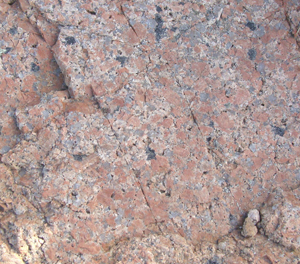 |
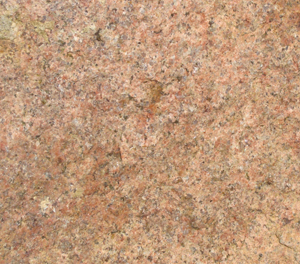 |
The two granites, Coarsely crystalline type and Le Mont Mado Aplogranite. |
| |
In 1989, this granite was described as the North-west granite (Bishop & Bisson, 1989, p. 52-55) consisting of two main granites, a western one, the St. Mary's granite which forms the north west corner of the island and an eastern one, the Mont Mado aplogranite, which crops out in St. John's Bay. |
| |
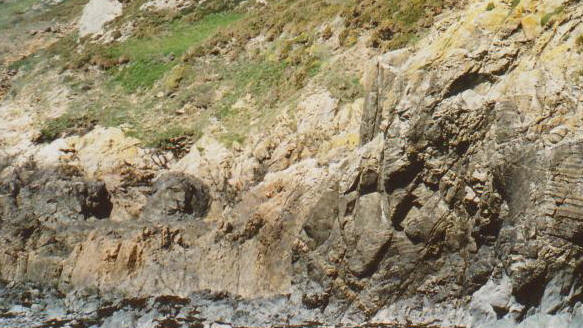 |
St. Mary granite - Jersey Shale contact, Le Pulec, St Ouën. |
| |
1. The St. Mary's granite forms the major part of the outcrop and varies from grey to pink and extends from L' Étacq at the northern end of St. Ouën's Bay where it's junction with the Jersey Shale Formation is well exposed at Le Pulec (see above). The St. Mary's granite contact with the adjacent Jersey Shale Formation is also well exposed in the small northernmost quarry at L'étacq where there is also some minor mineralisation. At Le Pulec inlet the irregular nature of the contact and associated acid dykes are well exposed. Here too, the shales have been thermally metamorphosed to give an aureole of a hornfels, spotted in part for c.100m. Inland, the contact is well covered by soil. Northwards via Le Pinacle to Gros Nez Point it crops out in spectacular pink, well jointed granite cliffs with thin aplite veins (below left). It is here too, around the entrance to Gros Nez Castle, that larger patches of more orange aplite can be seen (below right) some of which has been used as masonry for the castle. One of the few sills on the island can also be seen from here near the base of the cliffs to the south west. |
| |
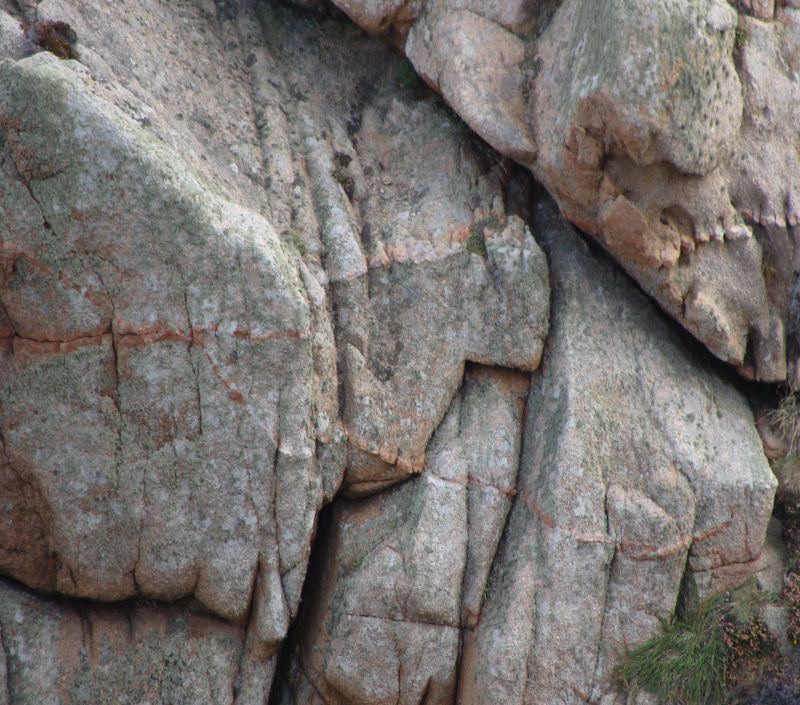 |
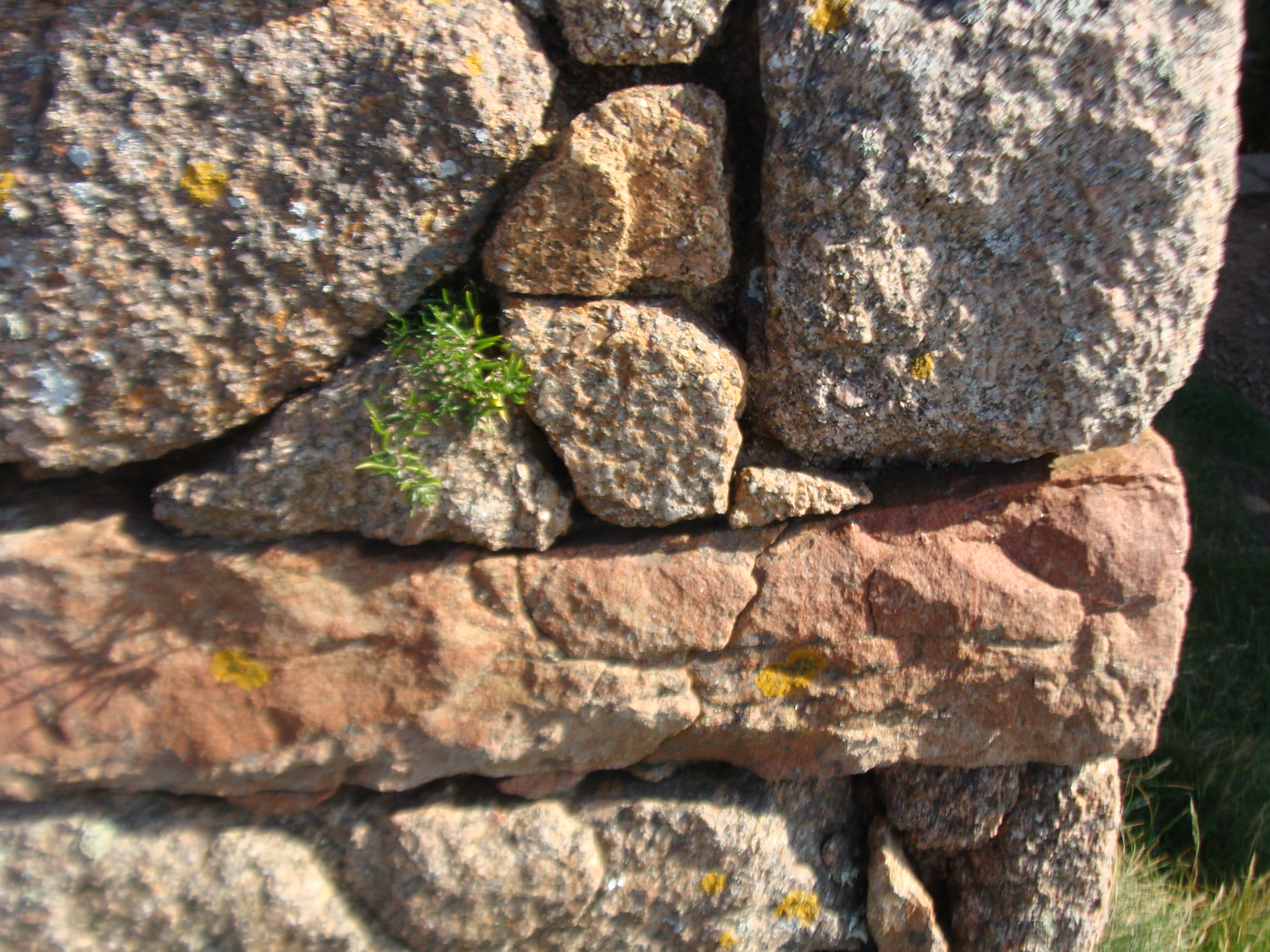 |
| |
It then continues eastwards via Plémont and La Grève de Lecq Bay to Le Côtil Point in St. John's Bay with several headlands in between, the most notable of which are Sorel and Ronez Points. They are notable geologically because here the granites are mixed with outcrops of gabbro, granodiorite and diorite. The North-west granite consists of the following two main granites with a whole-rock isochron age of 480 Ma (recalculated from 490 Ma) (Bishop & Bisson, p. 52).
It is a coarsely crystalline type with large crystals of quartz, orthoclase and plagioclase, some of the former being zoned, and minor biotite and hornblende. On Sorel Point and in Ronez Quarry, immediately to the east, this granite crops out with granodiorite, diorite and gabbro and also forms an aplogranite on Sorel and Ronez Points (Bishop et al, 2003, p. 35 - 36). The relationships between the several rock types, especially that of the granodiorite and diorite are described by Salmon (1996, p. 114 - 120), and although it is more friable in outcrop, the granodiorite is more compact sub-surface and is quarried more for this quality than the diorite. It has been quarried from L'Étacq, Les Landes and Grosnez, and is currently being quarried at Ronez Point and inland at Gigoulande in St. Peter's Valley. It passes at the eastern margin into; |
| |
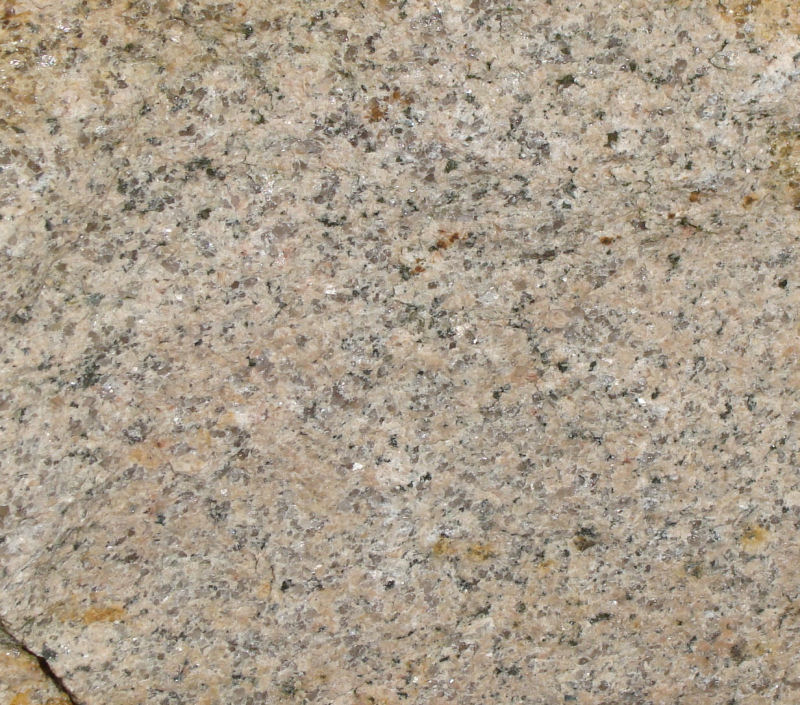 |
| |
2. The Mont Mado aplogranite (also the orange one above) which is a uniformly small crystalline granite which varies from pink and red to yellow and brown, and consists predominantly of quartz and feldspar. Scattered small crystals of hornblende are more frequent further west at La Saline.
At La Belle Hougue Point further east, the geology is more complex. It consists of altered diorite, intruded by granite to give a veined and brecciated appearance, similar mineralogically to the Ronez and Sorel rocks, and including a mass of the Jersey Shale Formation (Bishop & Bisson, 1989, p. 54 - 55). A large fault, named Les Rouaux, has faulted these rocks against various andesites of the St. Saviour's Andesite Formation and the Jersey Shale Formation. Further south, these in turn are faulted against the undivided Bouley Rhyolite Formation by the Frémont Fault. The granites vary from adamellites to monzonites because of their almost equal ratios of orthoclase to plagioclase and have a granophyric texture. Geologically, this area seems related to the nearby complex to the west.
In 1990, this igneous complex was described as the Northwest Granite Complex (Brown et al. 1990, p.195-6) and its outcrop was further subdivided into four varieties of granite, again arranged concentrically in an oval shape (presently a semi-circle due to erosion as with the SW granite but in this case open to the north). The outer granite included granodiorites, gabbros and diorites at Sorel and Ronez Points at its eastern end. In outcrop order from west to east, they are dated as follows;
1. An outer Coarse Granite (the St. Mary's above) dated at 438 +/-13 Ma.
2. Next, a Porphyritic Granite, similar composition to the St. Mary's dated at 465 +/-10 Ma.
3. A central Biotite Microgranite not dated.
4. An eastern Red Granite (the Mont Mado above) dated at 426 +/-14 Ma.
{NB. Two interesting similarities of this complex in comparison with the SW complex are; the oval nature of the outcrops, though presently arcuate opening northwards due to erosion and the younger granites forming the outer parts. It's frustrating that the inner Biotite Microgranite has not been dated and that its petrology has not been compared with that of the Red Granite of Mont Mado/La Saline}. In contrast to the SW granites, these are described as volcanic arc granites.
This granite complex is intruded by many aplite, dolerite and mica lamprophyre dykes, the latter being well exposed west of Plémont in the porphyritic granite cliffs at the back of La Grève au Lanchon where they strike c. WNW-ESE but also curve southwards. They are later than the aplites cutting them with a displacement of only a few centimetres. |
| |
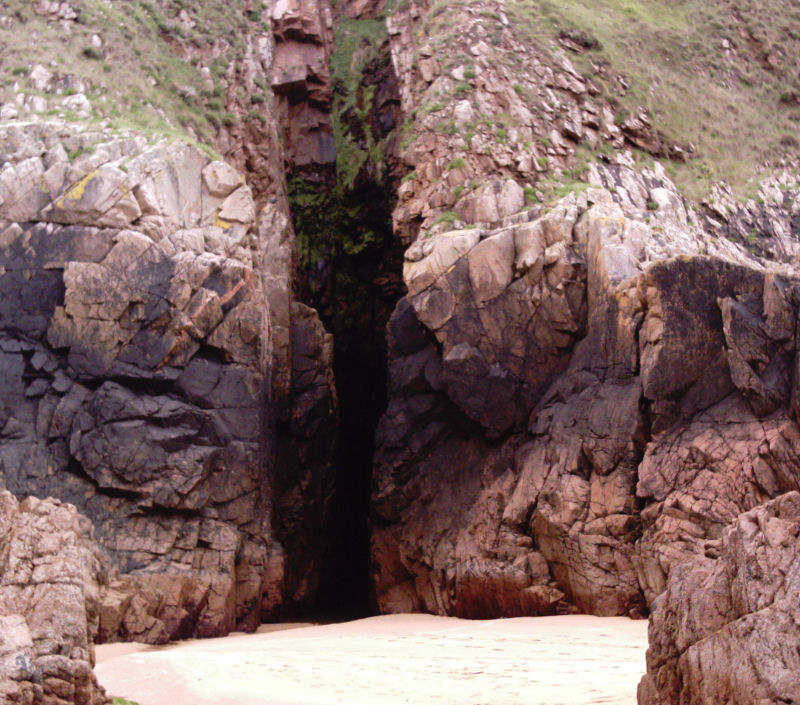 |
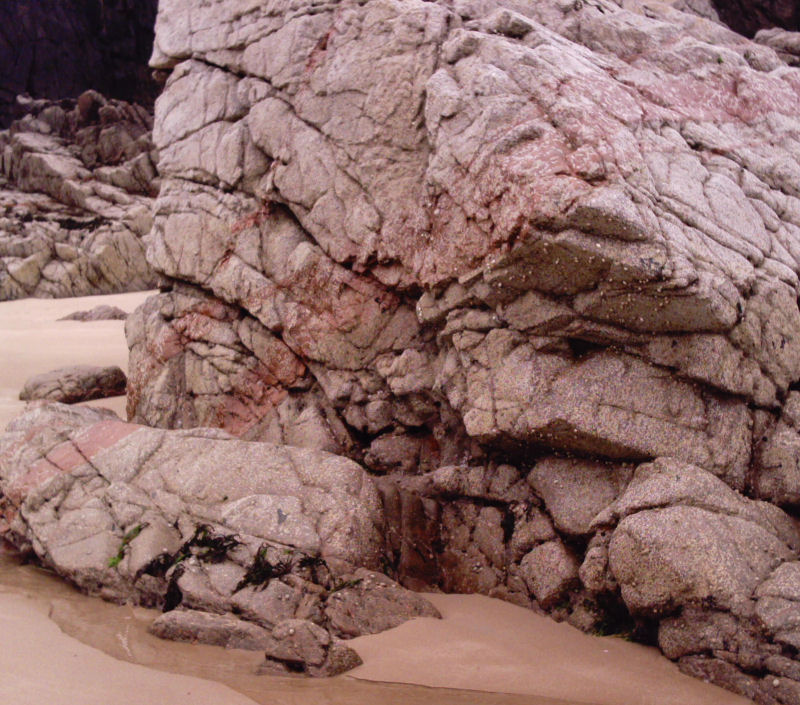 |
Cave eroded along master joints, Porphyritic Granite, Plémont. |
Aplite dykes and Porphyritic Granite, Plémont. |
| |
 |
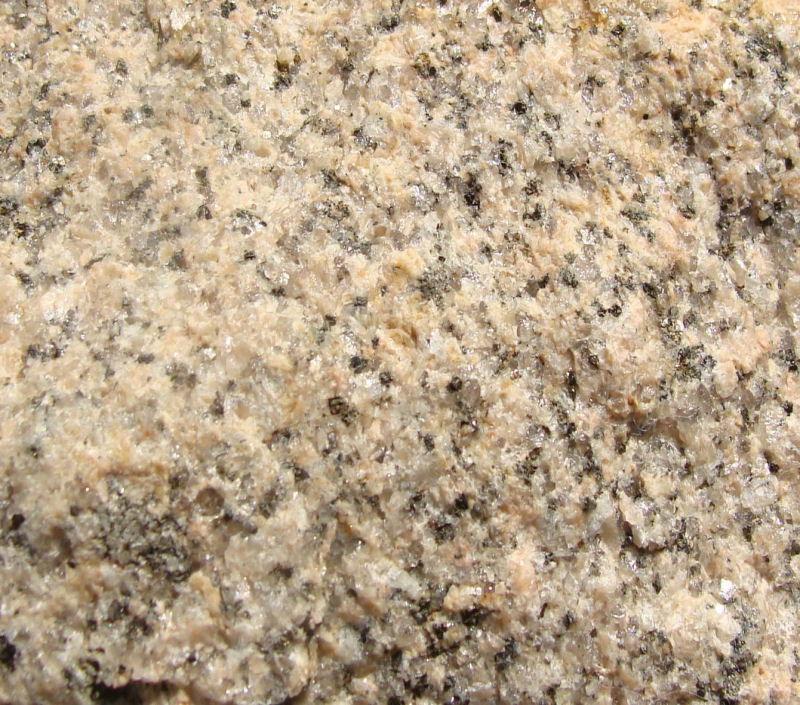 |
The Biotite Microgranite, weathered section and unweathered, at Le Rouge Nez. |
| |
 |
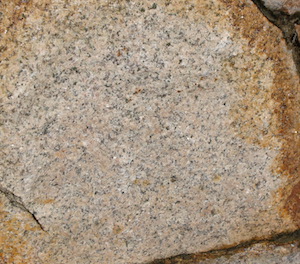 |
Liesegang rings occur in some parts of the Mont Mado
granite and not in others (above). |
Partially developed Liesegang rings, Mont Mado. |
| |
Another very noticeable feature of this area is the master joint pattern, where joints striking c. SW-NE have been strongly eroded to produce excellent caves some of which subdivide inside showing development along two master joints, notably in the cliffs at La Grève au Lanchon. |
| |
The Southeast Igneous Complex. |
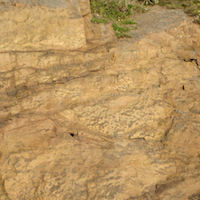 |
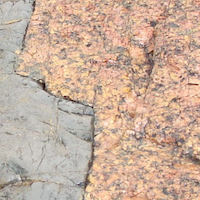 |
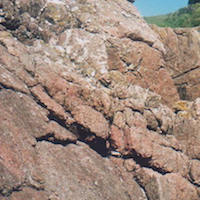 |
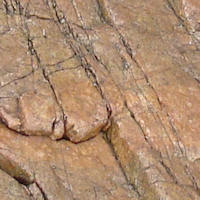 |
Ft. Regent granophyre. |
Coarse Le Dicq granite. |
La Rocque pegmatite granite. |
Gorey granite. |
| |
This complex, named the South-east granite (Bishop & Bisson, 1989, p.56-60), consists of several different granites, gabbros and diorites and forms the south eastern corner of the island. It crops out from St. Helier (including L' Islet de St. Helier - Elizabeth Castle) eastwards to La Rocque Point with a wide wave-cut platform to the south and east, then north to Le Mont Orgueil (Gouray Castle) midway along the east coast. It consists of the following four granites mixed with gabbros and diorites for most of the south coast with no reliable dates obtained as yet. In outcrop order from west to east, they are divided as follows;
1. The Fort Regent/Elizabeth Castle granophyre. This a pink-red to yellow granophyre which shows micrographic intergrowth of the orthoclase and plagioclase feldspars with quartz; biotite and other mafic minerals are rare. At Elizabeth Castle it has intruded dark grey diorite as sheets and contains xenoliths of it with sharp boundaries (below). |
| |
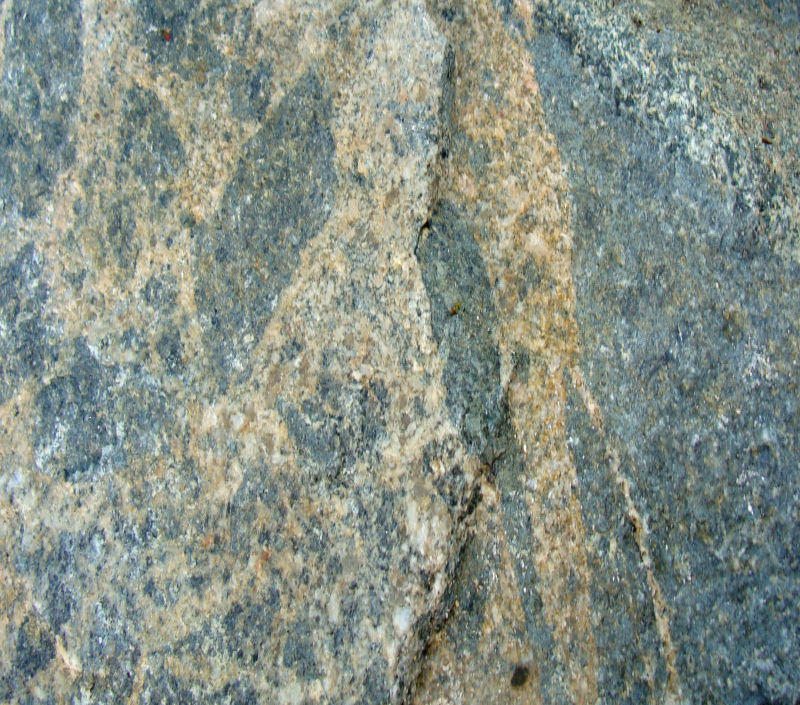 |
| |
A grey granitic rock represents a mixture of the the granophyre and diorite (Bishop et al. 2003, pp. 9 - 11). The diorites extend eastwards to La Collette while the Fort Regent mass consists of granophyre (Bishop, Keen, Salmon & Renouf, 2003, p. 10 - 12). A date for the Elizabeth Castle granophyre is given as 509 Ma (recalculated from 520 Ma, Bishop & Bisson, 1989, p. 59).
2. Further east, the Dicq granite crops out at La Grève d'Azette as reefs in the intertidal zone and is associated with masses of diorite (produced from gabbros by the granitic intrusion (Bishop & Bisson, 1989, p.56). It is a striking pink to grey granite (see 2nd.photo above) with large perthitic orthoclase crystal laths within a rim of plagioclase, set in a groundmass of large quartz, orthoclase, plagioclase, biotite and hornblende crystals. Xenoliths of fine and coarsely crystalline diorite cause a distinctive composite texture. Although aplitic granite occurs near the granite at Le Havre des Pas bathing pool, contacts cannot be seen, similar to the situation with the above granophyre. An isochron date of 570 Ma (recalculated from 580 Ma) is described as imprecise (Bishop & Bisson, 1989, p. 57).
3. North and east from Dyke Rock, the Longueville granite extends inland to Longueville. It crops out as a more yellow, coarsely crystalline granite, still with the same groundmass composition and diorite/gabbro xenoliths, but without the large orthoclase laths and with fewer quartz crystals in parts, making those parts more syenitic. Again, no contacts are visible and it may be a variation of the Dicq granite.
4. East along the coast, the La Roque granite crops out (after a fine beach section of diorite and gabbro) from Le Hocq to La Rocque Point and beyond to Seymour Tower, then north to Le Mont Orgueil at Gorey and inland to Grouville Arsenal. It is a striking pink-red granite showing an increase in size of the pink-red orthoclase and quartz crystals, producing aplites near Le Hocq, while at La Rocque, obvious positive and negative surfaces form parts of excellent pegmatites with large red orthoclase crystals interlocking with milky quartz (below). |
| |
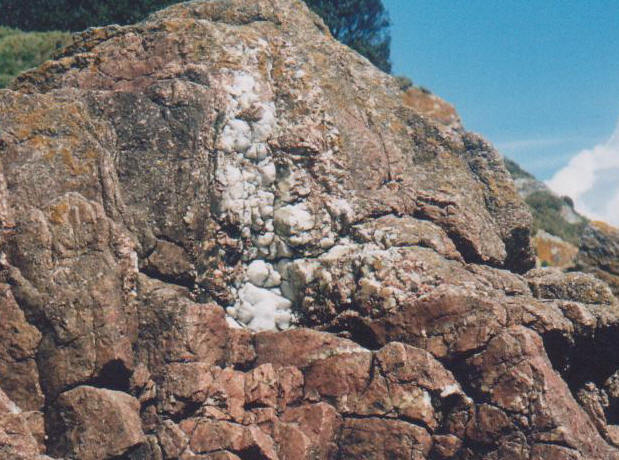 |
| |
Elsewhere, the large orthoclase crystals are perthitic and rimmed with plagioclase and occur with abundant quartz, biotite and hornblende. Towards Seymour Tower, there are possibly the last of the diorite and granite intrusive associations. The granite becomes browner northwards towards Le Mont Orgueil, and more medium crystalline with fewer quartz crystals, termed Gorey granite.
It has intruded the Jersey Shale Formation near Gorey and contains inclusions of rhyolite. To the north of Gouray Castle in Le Petit Portelet bay the contact with the Jeffrey's Leap Ignimbrite may be faulted or intrusive (Nichols & Hill, 2004, p. 16) and is intruded by a bifurcated mica lamprophyre dyke, well exposed on the beach section.
At Le Hocq, south of the slipway, there are excellent exposures of this granite intruded by many diorite dykes of the Jersey Main Dyke Swarm; they strike c. NE-SW and have an average width of c.1m (see Dolerites/Dykes pages).
Some dates have been obtained around 570 Ma (recalculated from 580 Ma) for the oldest but are considered unreliable. Field relationships show that the Dicq and Longueville granites are older and that the La Roque granite represents a younger intrusive phase. The relationships also show that the gabbro/diorite complex predates these granites (see Gabbro/ Diorite pages). Diorite intrusion in Normandy ended a phase in the Cadomian Orogeny and is dated at 590-580 Ma by Guerrot & Peucat (1990, p.13).
In 1990, these granites and the older diorites (and possible gabbros) were described as the Southeast Granite Complex (Brown et al.1990, pp. 196-7), and named the megacrystic Dicq Granite, passing north to the Longueville Granite with fewer megacrysts; and a younger, partly pegmatitic Le Hocq-La Rocque Granite passing north to a finer crystalline, lower quartz Gorey-Mont Orgueil Granite, and westwards into the Fort Regent-Elizabeth Castle Granophyre. This arrangement implies several intrusive episodes starting with the diorites, followed by the intrusion of the Dicq and Longueville granite(s), then by the Le Hocq-La Rocque and Gorey-Mont Orgueil granite(s)... with a link to the Fort Regent-Elizabeth Castle granophyre on the western side of the Complex Brown et al. loc. cit. p. 196). |
| |
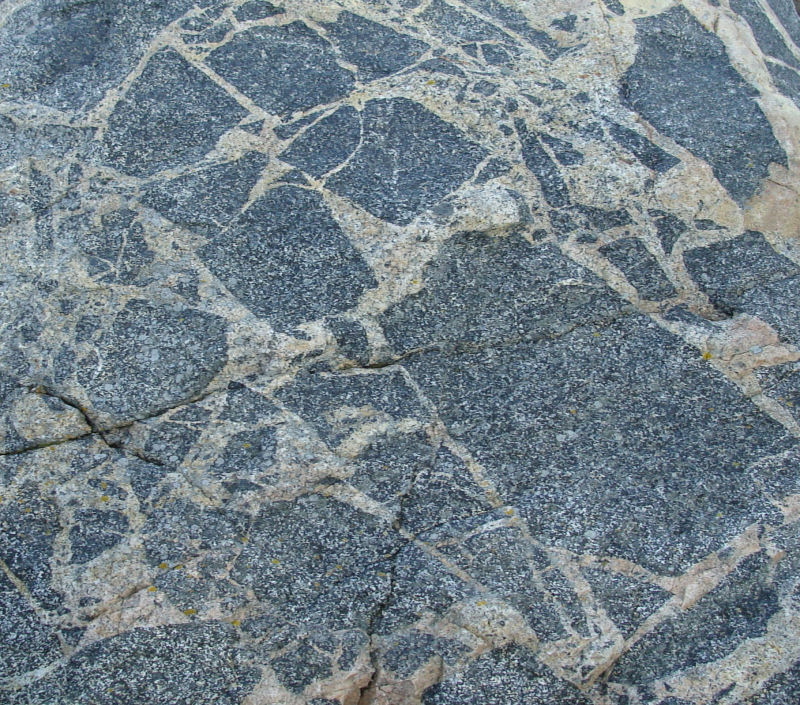 |
| |
They all show complex relationships with the diorites (above), the origin of which whether by alteration of gabbros or from dioritic magma has been strongly debated, and would give rise to an interesting cross-section, if one could be drawn without too many question marks!
The origins of the granites are fully described by Brown et al. (1990, pp. 196-197). In summary here, the geochemical data from C/NK v SiO2, Rb v SiO2, and Rb v Y+Nb studies indicate that the southwest granites formed within a plate while the northwest granites formed in a volcanic arc situation. In general, the mode of formation by a crustal assimilation model, with a mantle derived magma and a final closed system fractional crystallisation, would explain the data.
Microgranites and Composite dykes.
These have been mapped below Le Saut Geffray (Jeffrey's Leap) on the south side of Anne Port Bay, also to the south of Le Mont Orgueil and along the southern and eastern coasts of the Southeast Igneous Complex. The former are described as porphyritic micro-granites (Bishop & Bisson, 1989, p.66) and the latter as composite intrusions of quartz-feldspar porphyries with dolerite and appinites (hornblende, plagioclase porphyries (Lees, 1990, p. 277). These are excellently exposed between Le Croc and Le Nez Points along the beach outcrops either side of La Motte (Green Island) car park, the greatest variety and the best being at Le Croc Point (see Dolerite page). |
| |
|
References.
Allaby, A. and Allaby, M. 1990. A Dictionary of Earth Sciences. 2nd. Ed. Oxford University Press.
Bishop, A. C. and Bisson, G. 1989. Classical areas of British geology: Jersey: description of 1:25,000 Channel Islands Sheet 2. (London: HMSO for Brit. Geol. Survey.)
Bishop, A. C., Keen, D. H., Salmon, S. and Renouf, J. T. 2003. Geology of Jersey, Channel Islands. Geologists' Association Guide No. 41.
Brown, M. Power, G. M. Topley, C. G. & R. S. D'Lemos, R. S. 1990. Cadomian magmatism in the North Armorican Massif. p. 181 - 213, in The Cadomian Orogeny. Eds. D'Lemos, R. S., Strachan, R. A. & Topley, C. G., 1990, Geological Society Special Publication No. 51.
Guerrot, C. & Peucat, J. J. 1990. U-Pb geochronology of the Upper proterozoic Cadomian Orogeny in the northern Armorican Massif, France. pp. 13-26. In D'Lemos. R. S., Strachan. R. A. and Topley. C. G. Eds. 1990. The Cadomian Orogeny. Geol. Soc. Spec. Publ. No. 51. The Geological Society. London.
Lees. G. J. 1990. The geochemical character of late Cadomian extensional magmatism in Jersey, Channel Islands, p. 273 - 291 in The Cadomian Orogeny, Geol. Soc. Spec. Publ. No. 51. (see D'Lemos et al. above).
Nichols, R. A. H. and Hill, A. E. 2004. Jersey Geology Trail. Private publication printed by The Charlesworth Group.
Robinson, J. A. 1932. Geology Section 1931. Bulletin Annuel. p.7.
Salmon, S. 1996. Cylindrical granodiorite pipes in the Sorel Point Igneous Complex, Jersey, Channel Islands. Proceedings of the Ussher Society, 9 (1), pp. 114 - 120. |
| |
| |
| |
|